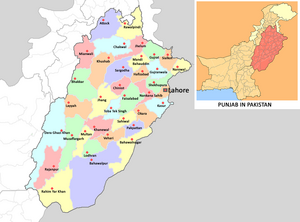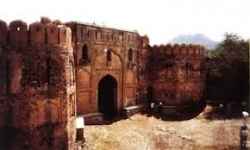Attock
- For the Historic city of this name see Attock Khurd

Attock (Hindi: अटोक) Urdu: اٹک) is a city and district in the Punjab province of Pakistan. Formerly it was called Campbellpur.
Variants
- Attock (Anabasis by Arrian, p. 279.)
- Atak (अटक), पाकिस्तान, (AS, p.16)
- Hataka (हाटक) (AS, p.1018):
- Attica (Anabasis by Arrian, p.27, 406.)
Location
Formerly Campbellpur, Attock is a city located in the northern border of the Punjab province of Pakistan and the headquarters of Attock District. It is located on the bank of the Indus, just 80 km from Rawalpindi, 100 km from Peshawar, and 10 km from the Pakistan Aeronautical Complex, Kamra.
Tahsils in the District
Jat Gotras
Andhar: In fact we find Andhar as a gotra of Jats, Origin of the which was place called Attock in Sindh.[1]
Jat Places Namesake
- Attak = Attacori (Pliny.vi.20). Attak or Attock is a city and district in the Punjab province of Pakistan.
- Attak = Attock (Anabasis by Arrian, p. 279.).Attak or Attock is a city and district in the Punjab province of Pakistan.
Jat Places Namesake
- Attak = Attica (Anabasis by Arrian, p.27, 406.). Attak or Attock is a city and district in the Punjab province of Pakistan.
Mention by Pliny
Pliny[2] mentions 'The Seres'....After the Attacori, we find the nations of the Phruri and the Tochari, and, in the interior, the Casiri, a people of India, who look toward the Scythians, and feed on human flesh. Here are also numerous wandering Nomad tribes of India. There are some authors who state that in a north-easterly direction these nations touch upon the Cicones11 and the Brysari.
11 See B. iv. c. 18. Click to see Jat Gotras in Attock
Main tribes
The Sardar, Khattar, Qanungoh Shaikhs,, Syed, Paracha, Awan , Pathans, Bangashs, Malik, Gujjars, Rajput, Qureshis, Mughal are the main tribes of Attock District.[3]
- The main Rajput tribes are the Alpial, Jodhra, Janjua, Chauhan and Bhatti. The Chauhan of Khaur, the Alpial of Chakri and Jodhra of Kamlial are important families in the district.But the greatest and royal family are the Malik tribes. they settled the main problems of the residential and made decisions for them.
The main Tribe of Royal Malik's is Awan.The malik of fateh jang and basal are mostly the landlords,The awan family of ,Dhurnal,Malal,Dhari-Rai-Ditta, Shah-rai-saidullah are important families in the District
History
Gandhara was an historic region of ancient India, (which corresponds to areas of north west Pakistan including Attock). Situated astride the middle Indus River, the region had Taxila and Peshawar as its chief cities.
It was originally a province of the Persian Empire and was reached (327 B.C.) by Alexander the Great.
The region passed to Chandragupta, founder of the Maurya empire, in the late 4th century B.C., and under Asoka was converted (mid-3d cent.) to Buddhism.
It was part of Bactria from the late 3d cent. to the 1st cent. B.C. Under the Kushan dynasty (1st cent.–3d cent. A.D.), and especially under Kanishka, Gandhara developed a noted school of sculpture, consisting mainly of images of Buddha and relief’s representing scenes from Buddhist texts, but with marked Greco-Roman elements of style. The art form flourished in Gandhara until the 5th century, when the region was conquered by the Huns.
Hindu Shahi Dynasty - In the early 11th century, Sultan Mahmud Ghaznavi launched seventeen expeditions into South Asia. In 1001, Sultan Mahmud of Ghazni defeated Raja Jayapala of the Hindu Shahi Dynasty of Gandhara, the Battle of Peshawar and marched further into Peshawar and, in 1005, made it the center for his forces. Attock became part of Ghannavi Empire. Many Sufi missionaries settled in Attock and converted the native population to Islam.
The Attock fort was completed in 1583 under the supervision of Khawaja Shamsuddin Khawafi, a minister of Emperor Akbar.[4] In 1759-60, Maratha forces had captured the Fortress of Attock.[5]
The Sikh Kingdom (1799–1849) under Maharaja Ranjit Singh (1780–1839) captured fortress of Attock in 1813 from the Afghan Kingdom (Attock then part of Afghanistan). After the decline of the Mughal Empire, the Sikh invaded and occupied Attock. The Muslims faced severe restrictions during the Sikh rule.
Then in 1849 Attock went to the British who created a district named it Campbellpur District. After 1947, the Pakistani Government renamed it as Attock in 1978.
The city's foundations were laid in 1903, and it was named Campbellpur after Sir Colin Campbell. The city was established near Attock fort.
Attock Fort

Attock Fort - Attock fort was completed in 1583 under the supervision of Khawaja Shamsuddin Khawafi, a minister of Emperor Akbar. The Mughal caravan sarai outside the fort, which is almost on the Grand Trunk (GT) Road, was also built during this period.
अटक
विजयेन्द्र कुमार माथुर[6] ने लेख किया है ...अटक (AS, p.16) पश्चिमी पाकिस्तान, का एक एक छोटा सा नगर है, जो सिंधु नदी के तट पर स्थित है जो अपनी सीमावर्ती स्थिति तथा ऐतिहासिक दुर्ग के लिए प्रसिद्ध है। प्राचीन समय में अटक को 'हाटक' भी कहा जाता था।[7] अटक का सुदृढ़ क़िला, जो नदी तट पर ऊंची पहाड़ी के शिखर पर स्थित है, उसे मुग़ल बादशाह अकबर ने बनवाया था। मध्य काल में अटक को भारत की पश्चिमी सीमा पर स्थित माना जाता था। यह कहा जाता है कि राजा मानसिंह ने अकबर द्वारा अटक के [p.17]: पार यूसुफजाइयों से लड़ने के लिए भेजे जाते समय वहाँ अपने जाने की सम्मति देते समय कहा था कि- "मुझे अन्य लोगों की तरह वहाँ जाने में आपत्ति नहीं है, क्योंकि 'जाके मन में अटक हैं, सो ही अटक रहा।"
हाटक
विजयेन्द्र कुमार माथुर[8]ने लिखा है .... हाटक (AS, p.1018): महाभारत सभापर्व में उल्लिखित स्थान है, जिसे यक्षों का देश कहा गया है. इस पर उत्तर दिशा की दिग्विजय के प्रसंग में अर्जुन ने विजय प्राप्त की थी- यह स्थान कालिदास के मेघदूत की अलका के निकट ही स्थित होगा. मानसरोवर यहां से समीप ही था- यह तिब्बत में स्थित वर्तमान मानसरोवर और कैलाश का निकटवर्ती प्रदेश था. यहां गुहयकों (यक्षों) तथा गंधर्वों की बस्ती था. श्री बी.सी. ला के मत में हाटक वर्तमान अटक (पाकिस्तान) है. एन.ल. डे के अनुसार यह हूण देश का नाम है.
देशवाल जाटों का राज्य
महाभारत युद्ध के बाद देशवाल जाटों का राज्य मध्यपूर्व में रहा। इसका एक प्रमाण यह है -
- सन् 41 में खरोष्टी भाषा में लिखा हुआ अरा (Ara) में शिलालेख है जो कि अटक के निकट है। उस पर लिखा है कि देशवहर (Dashavjara) ने अपने माता-पिता के सम्मान में एक कुंआ खुदवाया था। यह देशवाल वंशज जाट राजा था। यह जाट वंश पहले से अफगानिस्तान में आबाद था।[9]
In Jat History
Bhim Singh Dahiya [10] writes that Tughluk Khan's dynasty was of the Oghlan clan of the Jats who were Buddhists at that time. It should be mentioned that Khan is not a Muslim title, it is a pre-Muslim Central Asian title adopted by many Buddhist kings. It is derived from Khakan/ Kagan/Khan. This title was being used in India, as late as the fourteenth century A.D. Kalhana's Rajatarangini mentions a king, Alakhan of Gujrat (Punjab), and Jonaraja's Chronicles show that at the time of its capture by Sultan Shihabuddin of Kashmir (1354-1373), the ruler of Udabhaṇḍa (modern Und, near Attock), was one Govinda Khan.196 It is also well known to historians that in 1289 A.D. Jat king Arghun, son of Abaga had proposed to the Christians of Khurasan area, a joint attack on the Muslims who were a new rising power in the Oxus region. It was his successor Ghajan Khan who upon his accession to the throne in 1295 A.D., proclaimed himself a Muslim. He was the first Jat king who embraced Islam, and this marked the beginning of the process of conversion of Central Asia to that faith.
Bhim Singh Dahiya has described about the history of Lohar clan. This clan is famous in Kashmir history and gave it a whole dynasty called Lohar dynasty. Their settlement in India was Loharin, in Pir Pantsal range. The Lohar Kot-fort of Lohars-is named after them. The famous queen Didda, married to Kshemagupta, was daughter of Lohar King Simha Raja, who himself was married to a daughter of Lalli (Jat Clan) Sahi king Bhima of Kabul and Udabhanda (Und, near modern Attock)
Thus Didda was a Lohariya Jat scion, and a granddaughter of Lalli Jats of Kabul baseless called Brahmans. The descendants of their ruling family are still called Sahi Jats.
Queen Didda, made one Sangram Raj, her successor. He was the son of her brother Udaya Raj and he died on 1028 A.D. [11] Lohar itself remained with Vigrah Raj. [12]
In Mahabharata
Hataka (हाटक) (Country) is mentioned in Mahabharata (II.25.3),(II.25.5)
Sabha Parva, Mahabharata/Book II Chapter 25 mentions the countries Arjuna subjugated in the North, Arjuna arrives to conquer Harivarsha. Hataka (हाटक) (Country) is mentioned in Mahabharata (II.25.3)[13],(II.25.5)[14]....Arjuna crossing the White mountains, subjugated the country of the Kimpurushas ruled by Darunaputra,..... Having reduced that country, the son of Indra (Arjuna) with a collected mind marched at the head of his troops to the country called Hataka, ruled by the Guhyakas. .... And the exalted prince having arrived at the lake Manasa conquered the regions ruled by the Gandharvas that lay around the Hataka territories. Here the conqueror took, as tribute from the country, numerous excellent horses called Tittiri, Kalmasha, Manduka.
Notable persons
See also
References
- ↑ Dr Mahendra Singh Arya etc.,: Ādhunik Jat Itihasa, Agra 1998
- ↑ Natural History by Pliny Book VI/Chapter 20
- ↑ District Profile: Central Punjab- Attock
- ↑ Hasan, Shaikh Khurshid (2005). Historical forts in Pakistan. National Institute of Historical & Cultural Research Centre of Excellence, Quaid-i-Azam University. p. 37. ISBN 978-969-415-069-7.
- ↑ Mehta, Jaswant Lal (1 January 2005). Advanced study in the history of modern India 1707-1813. Sterling Publishers Pvt. Ltd. p. 260. ISBN 978-1-932705-54-6.
- ↑ Aitihasik Sthanavali by Vijayendra Kumar Mathur, p.16-17
- ↑ हिस्टॉरिकल ज्योग्रफी ऑफ एंशेंट इंडिया- बी.सी. लॉ, पृ. 29
- ↑ Aitihasik Sthanavali by Vijayendra Kumar Mathur, p.1018
- ↑ Jat History Dalip Singh Ahlawat/Chapter XI,p.999
- ↑ Jats the Ancient Rulers (A clan study)/The Jats,p.67
- ↑ RAJAT, VI, 355 and VII, 1284
- ↑ For details see, RAJAT, Vol II, p. 293; Steins note.
- ↑ तं जित्वाहाटकं नाम थेशं गुह्यक रक्षितम, पाकशासनिर अव्यग्रः सह सैन्यः समासथत (II.25.3)
- ↑ सरॊ मानसम आसाथ्य हाटकान अभितः परभुः, गन्धर्वरक्षितं थेशं वयजयत पाण्डवस ततः (II.25.5)
Back to Pakistan

